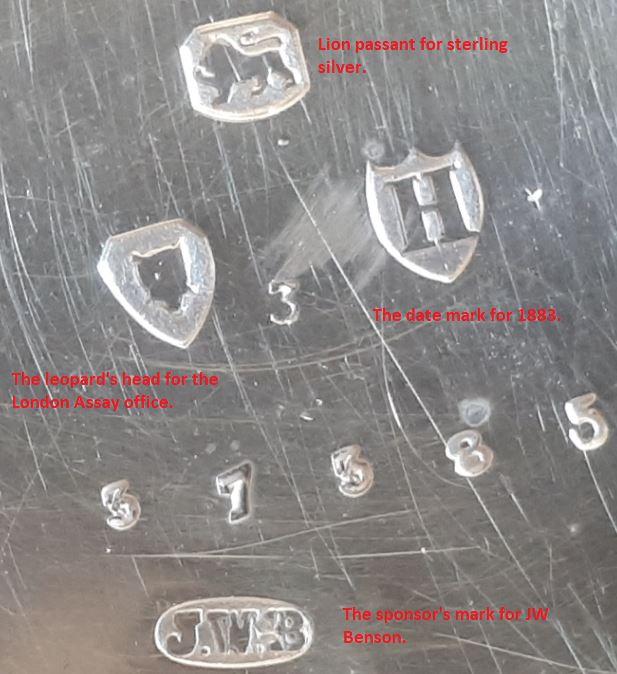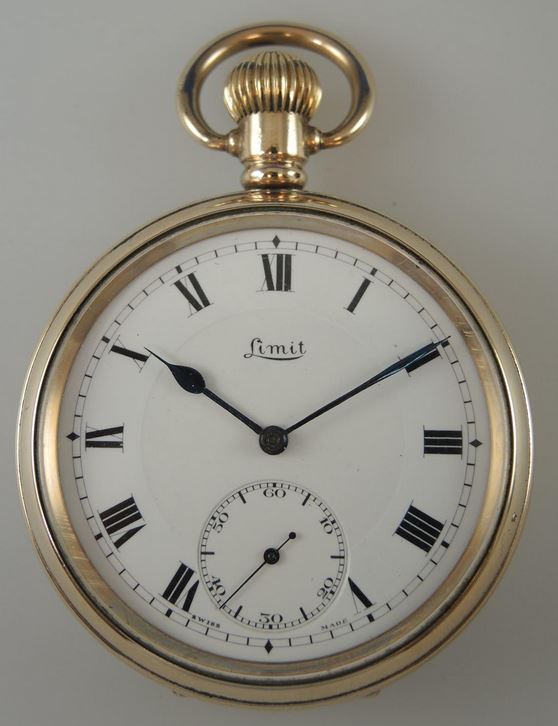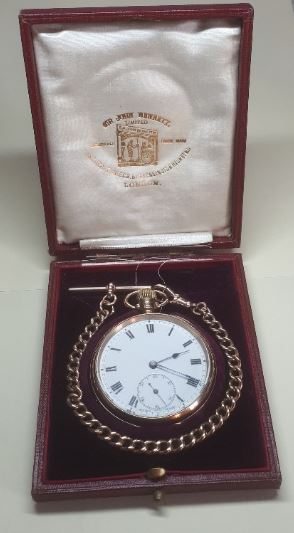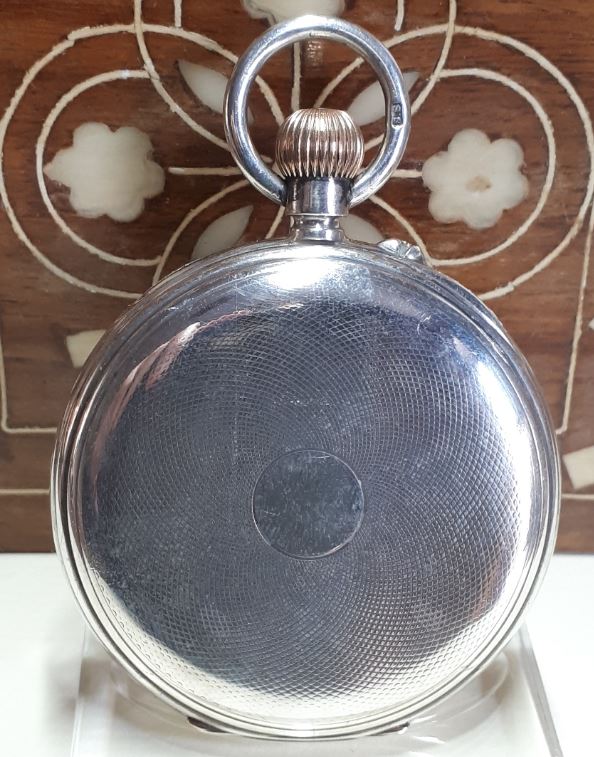Last updated on October 12, 2025
What’s the difference between an antique and a vintage watch?
The UK Trading Standards has no clear definition of what constitutes an antique. However, from the perspective of this website, we consider that antique watches are at least 100 years old. The exact definition of vintage is slightly more flexible than antique. However, generally speaking, a watch is considered vintage if it falls into the 20 to 99-year age bracket.
How do I determine the age of an antique watch?
There are several ways to determine the age of an antique watch. One is the serial number on the movement, which can be cross-referenced with the manufacturer’s database. This will generally give a narrow range of years in which the movement was made. The serial number might not be easily accessible. If you are lucky, it will be engraved on the back of the movement and will be visible when you open the case back. However, many movements will have been constructed with the retailer in mind, and the serial number will be hidden under the dial. At the time, the term watchmaker was quite vague, and rarely was the seller of the watch the actual manufacturer. Hence, the serial number and maker’s mark were hidden. If this is the case, you will need the tools and the confidence to take apart the watch to locate the relevant marks.
Hallmarks
British hallmarks on the case are another method for determining the age of the watch. These markings are required by law in cases made from precious metals such as silver or gold. Precious metals are typically not used in their purest form. They tend to be alloyed with other metals to improve durability and workability. Hallmarks are symbols applied to precious metals to indicate the amount of pure metal in the alloy (What is a hallmark? at the London Assay Office).
There are several marks indicating the Sponsor’s mark, the Assay Office mark, the Date Letter and the Fineness mark. The hallmark acts as a guarantee to the purchaser that the case has been certified as a precious metal. The Date Letter can be used to determine the age of the watch. This, of course, assumes that the watch case and the movement started life together. If the watch has been re-cased, such as a marriage watch, dating becomes much more difficult.
Manufacturer
There are a couple of other methods that can help estimate the age of a watch. If you know the manufacturer of the movement and the dates that they were in business, you can get a broad idea of the watch’s age. For example, the Lancashire Watch Company was in business from 1889 to 1911. Brand names can also help age a watch. For example, the Limit brand was registered by Hirst Brothers in 1912. Generally, if a watch cannot be specifically dated by a serial number or a hallmark, its age is considered to be an estimate. In this case, it would be listed as ‘circa’ (approximately), for example, c1910. Additionally, Mikrolisk, the Horological Trade Mark Index, is a useful source for determining when a trademark was registered.
Personalised engravings on watch cases often include the date. This is particularly the case for watches presented for significant life events, like 21st birthdays or retirements. In theory, the date should correspond closely to when the watch was made. Many collectors want their timepieces to be as authentic as possible, and an engraving can detract from the watch’s originality. This clearly lessens the demand, the price and therefore the resale value.
Finally, you could reach out to a specialist auction house to determine the age of a watch. Generally, they will have a team of experts who will be able to advise. Many auction houses offer free evaluation services or have specific valuation days.
Is my antique watch valuable?
Probably not. Pocket watches were made in their millions, and many survive in working condition to this day. If you have had any success in identifying the maker and the age of the watch, then you can use online auction results to determine an approximate value. If it is a family heirloom, treasure it for what it is and don’t worry about its value. Typically, the sentimental value will far outweigh the monetary value. A full service for an antique pocket watch typically costs around £120, which could represent 25 – 50% of the value of an average antique watch.
The factors that do increase the value of an antique watch include rarity, the manufacturer, the precious metals in the movement or the case and the number of complications. If you do have a watch that you consider exceptional, it would be worth having it professionally assessed at an auction house.
Does the condition of an antique watch affect its value?
The condition of an antique watch certainly does affect the value of the watch. Watch collectors generally prefer a watch that has little wear and tear, or patina, believing it to have more character. However, there is a clear distinction between patina and damage (Patina on vintage dials at Beyond The Dial). In general, collectors tend to shy away from antique timepieces that have been restored to ‘as new’ condition. A watch that is broken, non-running or in need of a service will have its value reduced by the cost of the work required.
Condition ratings for antique watches
New old stock
New old stock (NOS) refers to an antique watch that was never sold to a customer and is still in its original packaging. It is extremely rare to come across a genuine antique watch that is considered new old stock. The total condition of the watch is 100%.
Mint
This watch is very close in condition to New Old Stock. The watch has been used, but shows very little sign of wear. There is no sign of oxidation on the case, although there may be some minor patina. The watch dial is free of any imperfections, such as hairline cracks. The mineral glass is free of cracks or chips. The total condition of the watch is 95% or better.
Near Mint
This watch shows minor signs of being used and has some obvious patina. There is no sign of oxidation on gold-filled items. There may be slight blemishes present on the case, but they do not detract from the appearance. The watch dial is clean, but it may show slight discolouration or hairline cracks. The total condition of the watch is 90% or better.
Excellent
This watch shows slight patina from normal daily use. There may be some oxidation on gold-filled items. The watch dial will show discolouration, minor blemishes and hairline cracks in the enamel. The total condition of the watch is 80% or better.
Very Good
This watch shows patina from normal use. There is oxidation over most of the gold-filled items. The watch dials show stains, blemishes, or distinct hairline cracks. The total condition of the watch is 70% or better.
Good
This watch shows signs of heavy usage. There is oxidation and possible dents, dings, or scratches present on the watch case. The watch dial is unappealing. The total condition of the watch is 50% or better.
Below Average or worse
This watch is likely not working. It is not collectable in its current condition unless it is a very rare timepiece. The watch dial is discoloured to the point where it should be restored. The piece is only suitable as a restoration project.
Can I engrave my antique pocket watch?
The simple answer is yes, it’s your watch and you can do what you like with it. However, you should really only engrave on solid metal watch cases, such as solid gold, silver, nickel and alloy cases such as Silveroid. If the case is plated or filled, the engraving is likely to etch through to the underlying base metal. Engraving Gunmetal will probably not end up with a pleasing result.
Engraving a watch case is generally not a good idea, and I would strongly recommend against it. It will almost certainly lower the value of the watch. It will affect the originality of the piece and therefore its resale value. A much better idea is to personalise a fob that can be attached to the watch chain.
Related content
A beginner’s guide to antique pocket watches.
Watch Grading Guide by William May.
Tissot serial number, Longines serial number, Omega serial number, Zenith serial numbers.




I have an antique Limit pocket watch that has been passed down through my family. It was useful to read about the Hirst Brothers who made the watch. My watch dates to around 1910 and belonged to my great grandfather. The watch is in good condition and works well. I was thinking of getting it engraved with my great grandfather’s name, but now having read this article, I will leave it as is. Thanks for all of the useful information and advice.
Thanks for this post. It has been really useful. I inherited an antique silver Limit pocket watch which has been passed down through the family. Based on the British hallmarks it dates to 1911. I used your advice to value it by looking at completed auction prices. As you said, the sentimental value far outweighs the monetary value. It means a lot to me as it belonged to my great-grandfather who I unfortunately never met. It works well after sitting in a drawer for decades. Should I consider getting it serviced? Thanks.
Hi Gaynelle, I’m pleased that the post was useful. The lubricants in the watch would have dried out years ago, so I think it is definitely worth getting your antique watch serviced to protect it for future generations. Typically, modern lubricants last for about 10 years. Once it is serviced try and wind the watch every couple of weeks to ensure the oils spread throughout the movement. Thanks for taking the time to comment, Jason.